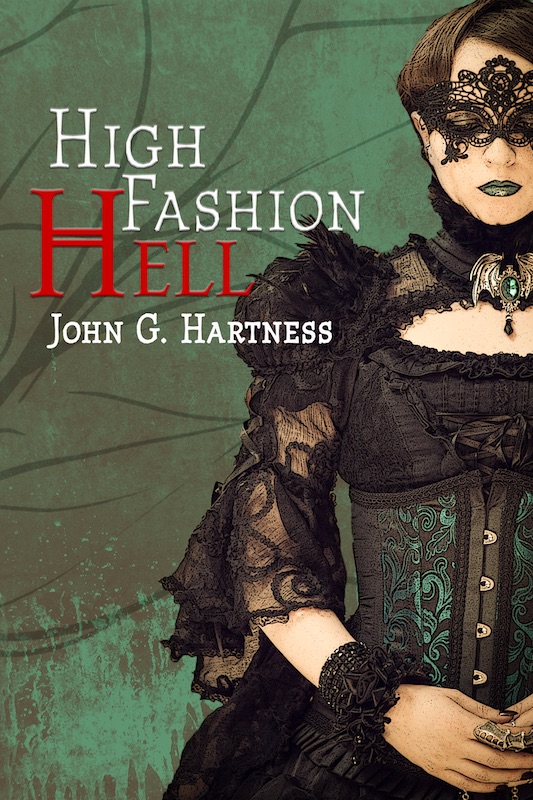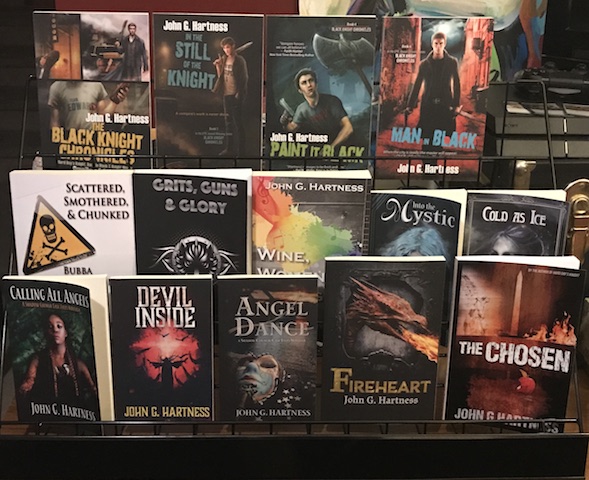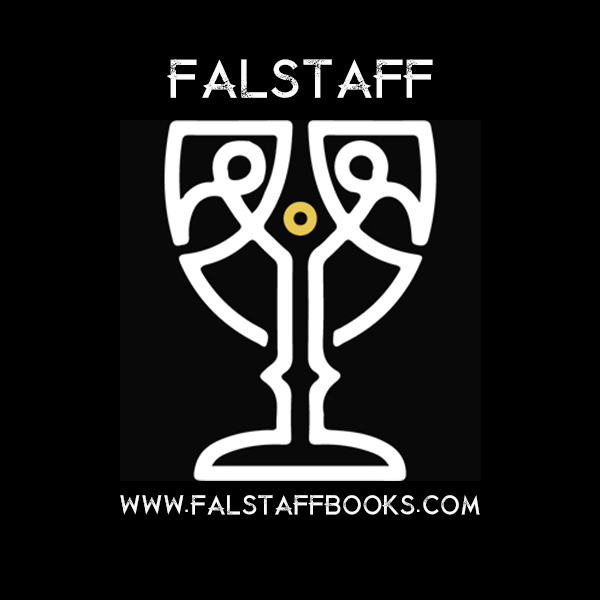
by john | Feb 23, 2015 | Book Spotlight, Evolution of Evil, Writing
Quieter Horror
by J. T. Glover
Late in 2013 I sprained my back, and several months passed while it healed. During the period when my spine looked less like a straight line and more like a question mark, I wrote “Mercy’s Armistice” for The Big Bad II. Most of it was dictated using speech recognition software, because sitting down for long periods was out of the question—standing was only somewhat less painful, but lying down actually worked all right. Things came together, I submitted the story, and John & Emily took it.
What does my tale of woe have to do with the evolution of evil? Just this: by the time I actually started writing, the pain was large enough that I was distracted. Decayed noblemen with fangs and capes seemed patently ridiculous, and the same went for most everything else from the canon of Big Bads. The zombie apocalypse is a very distant concern when you’re dropping mugs, showering is a fraught activity, and getting into a car involves an IKEA-like diagram of turns and shifts.
One afternoon in December I wound up re-watching The Godfather for the nth time, and something clicked. The world that Mario Puzo described and Francis Ford Coppola immortalized is made up of those who are family, those who are not, and those who wish they were. What, I started to wonder, about the people who weren’t part of any of that, or of the square world? What about the true outsiders—skip the heroin chic, dodge the beautiful gutters—what about the truly desperate?
And then, as often happens for me, I put two and two together. What happens when hit men get old? Luca Brasi wasn’t a young man when he went to sleep with the fishes, but we saw little of his mundane life. Everyone ages, contracts this or that illness, eventually dies—but most of that doesn’t happen on screen. “How” I asked myself, “would it work for a couple of aging supernatural predators who had to take care of a sick relative?” That was the point at which the engine actually turned over and the Muse took the wheel.
I like the tight, well-plotted headliners of horror that sweep me along, but I also like the quiet and mundane: Caitlín R. Kiernan’s “Standing Water,” T.E.D. Klein’s “Growing Things,” David Searcy’s Ordinary Horror, any number of stories by Shirley Jackson. The empty spaces between the evisceration of hapless victims and the howl of the Beast can be horrifying, too. In those moments, I think it’s easier to look past the fur and the fangs and see the so-familiar face that hides underneath the mask.


by john | Feb 20, 2015 | Book Spotlight, Evolution of Evil, Writing
James R. Tuck is my brother from another mother, one of my favorite people, one of my favorite writers, and one of the best friends I’ve got in this business. I love everything he writes, from Deacon Chalk to the Big Bad, and it’s always an honor to have him share his words with me in these anthologies. Here’s his story about his story.
It’s Neil Gaiman’s fault.
Kind of.
Well, he’s good enough to blame anyways.
My story in the last one had a supervillian, and he was evil, but for Big Bad 2 I wanted to go really evil. Old school evil. Hardcore evil.
I put on my thinking cap and came up with the concept of the Devil in a concentration camp.
Can’t really get more evil than that now can you?
I needed a reason for him to be there and so I ripped off Gaimen. In my story, we have a Devil who, as part of his curse, is forced to live a human life every year. (If perchance you do not know how this is ripping off Neil Gaimen then stop and immediately order DEATH: THE TIME OF YOUR LIFE by him. Hell, just go ahead and pick up the Sandman Omnibus vol 1 & 2. You’ll thank me for it.) This fits with the narrative of the Bible as we have a few occurances of Old Slewfoot showing up and actually being a real presence.
The Devil HATES these days and he doesn’t ever want to do them. He’s been able to push off these mandatory human life days longer and longer as his power grows. This is the reason he believes he will one day be able to win his struggle against God.
However, the day has come upon him in the middle of World War 2, and he decides to take over the life of a concentration camp guard.
My plan when picking this was to go full-bore evil. I had the Devil’s number, got him in one fell swoop as a right bastard, just the kind of prick you’d think the Prince Of Darkness would be.
Oh, this story was going to be some truly twisted, therapy-inducing horror.
Then Hadassah showed up.
Simple Hadassah. Straightforward Hadassah. Courageous Hadassah.
She ruined my plans and made this story about something else, something more. There is evil here, it’s on the page and in the subtext, but with Hadassah the story became about humanity. The ability we have to hold to our own faith and dignity even in the very mouth of the devourer. I’ve written many tales in my time. Some of them have been damn good.
This story is one of them I am most proud of.
It’s outside my wheelhouse, far outside my voice, and it’s about something.
No, it’s about somethings. There’s a texture to it that I’m pleased with. Normally I write very surface, guns and monsters and things that go boom, but not in this time.
This is a quiet story.
Enjoy.


by john | Feb 19, 2015 | Book Spotlight, Writing
Don’t Breathe Out
by
Sarah Joy Adams
Some things were strictly forbidden in my house while I growing up and Horror was definitely on the list. My mom had seen a horror movie once, peeking out from behind my grandfather’s armchair when she was supposed to be asleep, and it gave her nightmares for years. Between my mother’s (entirely understandable) desire not to let her kids have their own years of nightmares and the fact that we didn’t have cable there weren’t a lot of opportunities for me to find out what horror was. I grew up with the vague impression that horror meant Stephen King and teenagers getting hacked to pieces. Since I liked my teenage babysitters and had enough childhood fears of my own to be getting on with, the prohibition on Horror was not one I was eager to break.
Besides, my local library had plenty of other books for me to read that were perfectly acceptable. Mythology was a whole other thing, right? And the Brother’s Grimm was fairytales, so that was okay. And ghost stories were….okay, mom probably didn’t want me reading those either, but I snuck a few home every once in a while, telling myself that they didn’t count because they were real. So I grew up reading about Blue Beard’s Chamber and Saturn devouring his children and any number of creepy old houses inhabited by vengeful spirits. Not to mention Little Red Riding Hood – for years, I was sure there was a pony sized wolf waiting behind the bathroom shower curtain to eat me all up.
The result was that I grew up without a sense of horror as a genre, but a really strong sense of what was horrifying. For me it’s not about big scary monsters, but about visceral, lingering fear. This is why Jabba the Hutt’s rancor monster trying to eat Luke was, to me, just a cool fight scene, but his little dog-rat-thing chewing on C3PO’s eye was the stuff of nightmares. Give me a good light saber and that monster’s dead. But the little rat thing will sneak up on you and eat your face when you’re most vulnerable. This is how Lovecraft managed to make geometry and colors terrifying. (If that doesn’t ring a bell go read “Brown Jenkin” and “The Colour out of Space.” Just don’t read them late at night.)
It can be sudden and bladder clenching or it can be slowly dawning realization, but either way, effective horror induces what Emily Dickinson called the “zero at the bone.” Good horror is the difference between gore and pain. Blood is just blood. It can be cleaned up. It can even be funny. Pain is inside you, inescapable. Effective horror creates that gut clenching fear of inescapable pain. It makes you feel small and helpless, that your only hope is to freeze so the evil thing doesn’t see you.
Read more from Sarah in The Big Bad 2!


by john | Feb 18, 2015 | Evolution of Evil, Guest Blogs, Writing
Monsters, Trailer Parks and Truck Stops
By Gail Z. Martin
People who aren’t from Pennsylvania picture two cities: Pittsburgh and Philadelphia. If you’re from PA, you know that the state’s whole center is farmland and nearly uninhabited forest (drive across I-80 sometime and you’ll see what I mean). Where I grew up, in the top corner near Lake Erie, not only do most people have a taxidermist on speed dial, but I’m pretty sure the car dealerships not only sell pickup trucks with gun racks as standard equipment, but I think the guns may be part of the package. Schools and businesses officially close for the first day of Deer Season. Most people I knew could field dress a deer with a pocket knife.
This matters because there’s urban horror and then there’s rural horror. They play off different kinds of fears. Urban horror plays off the anonymity of the big city, the strangers, the manmade caverns of concrete and the trackless tunnels underneath, dark alleys and seedy neighborhoods. Rural horror is a little more primal: wild animals, crazy loners holed up in caves or cabins, the brutal Darwinism of the elements and the fear of what you find in the vast, empty darkness, far away from street lights or cell phone signals.
My story for Big Bad 2 was inspired by getting lost in rural areas, and unexpected inspiration at a truck stop.
We’ve still got family in Northwestern PA, even though we’ve been in North Carolina for nearly 20 years. So we have worn a groove in I-77 and I-79 North over the years, heading nearly all the way up to the shores of Lake Erie. We’ve got the drive down to a science, and we trade off drivers every two hours at our favorite places to stop. One of those is a Flying J truck stop in Fort Chiswell, VA. It’s one of those restaurant/gas station/convenience store/gift shop kind of places, and one day, as I was getting a huge cup of coffee for the road, one of their t-shirts caught my eye.
“Mess with me, and you mess with the whole trailer park.” The guy depicted on the graphic looked like someone out of Cabin in the Woods, not the shell with the most gunpowder, if you know what I mean. But for some reason, that statement of backwoods solidarity got me thinking. What if the trailer park was full of monsters? Hmm.
Getting lost in a city can be scary if you end up a bad neighborhood. Getting lost in rural areas means you’re not in anybody’s neighborhood. Three 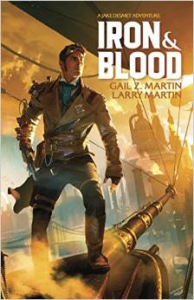 situations made an impression on me. In one case, it was late at night, we were back home in what should have been our stomping grounds, and we missed a turn on a rural road. No problem, we had a pretty good idea of where we were, and we took the next left, expecting it to cut across. The blacktop road went from two lanes to one lane, then became a gravel road, then a dirt road. This was before GPS. I thought our odds were good of ending up in front of someone’s barn, facing a big German Shepherd and the business end of someone’s shotgun.
situations made an impression on me. In one case, it was late at night, we were back home in what should have been our stomping grounds, and we missed a turn on a rural road. No problem, we had a pretty good idea of where we were, and we took the next left, expecting it to cut across. The blacktop road went from two lanes to one lane, then became a gravel road, then a dirt road. This was before GPS. I thought our odds were good of ending up in front of someone’s barn, facing a big German Shepherd and the business end of someone’s shotgun.
Now we probably would have been OK. We were on home territory, and that meant we could have played the “Do you know my parents, aunts, cousins, cousin’s sister-in-law’s aunt’s neighbor” verification-by-relative game. But it’s a scary thing bouncing down a road without street lights that isn’t on the map and where there are no signs to tell you which road you’re on if the mile markers aren’t enough for you to know. There’s a whole lot of dark emptiness out there.
Another time, we had to get off I-79 onto a detour in West Virginia because of road construction and we somehow lost the detour. This is a bad thing if you’re not from there, and we aren’t. See, there are what’s called “hollers”, or mountain valleys. There’s the front of the holler and the back of the holler. First rule: you don’t go into the holler if you don’t belong there. Second rule: you don’t come out of the back of the holler if you go in there and you don’t belong there. It was a ‘paddle faster, I hear banjos’ kind of moment.
Then there was the time I was taking my daughter back to Penn State, which is in the middle of the state and the middle of nowhere. We missed a turn (ok, maybe I shouldn’t navigate), and said ‘that’s OK, we’ve got GPS’. Yeah well. Instead of four-lane highway, we took a charming scenic detour through increasingly smaller hamlets on one-lane roads that were wavier than pan-fried bacon. I was fine with it—it was daylight, we had a full tank of gas, and it wasn’t like we were going to run into cow gangs from the wrong side of the tracks. There were even places where the cell phones kinda worked.
But my daughter, raised in Pittsburgh and Charlotte, got more and more nervous the farther we got from ‘civilization’. When I stopped for gas at a no-name station in a tiny one-traffic-light town and had to pay inside (horrors!) she actually locked the car doors until I came back. (Just because everyone in sight is wearing camo does not mean you’re in danger. Up there, they sell camo lingerie and camo baby onesies, just sayin’.) But her nervousness outside her comfort zone got my writer brain working on what makes us afraid.
Put it all together, and you get “Old Nonna,” my story for Big Bad 2.
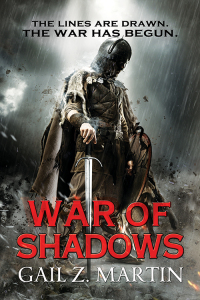
About the Author:
Gail Z. Martin is the author of the new epic fantasy novel War of Shadows (Orbit Books) which is Book Three in the Ascendant Kingdoms Saga; Vendetta: A Deadly Curiosities Novel in her urban fantasy series set in Charleston, SC (Solaris Books); and Iron and Blood: The Jake Desmet Adventures a new Steampunk series (July 2015, Solaris Books) co-authored with Larry N. Martin. She is also author of Ice Forged and Reign of Ash in The Ascendant Kingdoms Saga, The Chronicles of The Necromancer series (The Summoner, The Blood King, Dark Haven, Dark Lady’s Chosen) from Solaris Books and The Fallen Kings Cycle (The Sworn, The Dread) from Orbit Books. Gail writes two series of ebook short stories: The Jonmarc Vahanian Adventures and the Deadly Curiosities Adventures and her work has appeared in 20 US/UK anthologies.
Find her at www.AscendantKingdoms.com, on Twitter @GailZMartin, on Facebook.com/WinterKingdoms, at DisquietingVisions.com blog and GhostInTheMachinePodcast.com, on Goodreads https://www.goodreads.com/GailZMartin and free excerpts on Wattpad http://wattpad.com/GailZMartin.
by john | Feb 17, 2015 | Guest Blogs, Writing
Welcome back Selah Janel to talk about Women in Horror Month! For more Selah, check out her website.
Although I grew up something of a scaredy-cat, admittedly I’ve always been drawn to the horror genre. I was the one always begging friends to tell me blow-by-blow details of the movies I wasn’t allowed to see, the one reading the descriptions of horror movies off boxes in video stores when my parents weren’t looking, the one who may or may not have run an underground library for R.L. Stine titles and urban legend collections out of my locker in Junior High. I think we take for granted that women seem to be designated as chainsaw fodder or final girl in the genre, when there are truthfully a lot of other roles if we keep an open mind and are open to a lot of different titles. I also don’t think it’s that unusual that women make awesome horror authors. I could give you the standard answer of how we’re emotional creatures and at the end of the day we always have to be aware while walking down the street, when we’re meeting someone new, when we have to walk away from a table and leave our drink unattended, when protecting our children, etc.
However, I think there’s another reason women of my particular generation are drawn to horror and happen to be good at it. It’s a little thing I like to call the 1980’s.
Stay with me here. Yes, the eighties were time when slasher films ruled and women’s roles tended to be reduced to victims for the most part, but that’s not what I’m talking about. To really get why my ilk are into the genre, you have to go to a whole other medium entirely: children’s cartoons.
Eighties nostalgia has gotten a lot of flak over the years. Yeah, a lot of the cartoons were made off toy lines and they weren’t always drawn very well. A lot of the Saturday morning installments didn’t even last all that long, if a whole season. What they were, however, is utterly, completely, cracked out.
Let’s just take a look at some of my early influences, eh? The first Care Bears movie features a book that could be considered a riff off the Necronomicon. Heck, the second movie contains shapeshifting demons and a variation on possession. Yes, the villains are either dealt with or reformed, but can you imagine that even existing in a theatre for four-year-olds these days? My Little Ponies had gateways to other dimensions and a dark ooze that nearly destroyed Ponyland. Rainbow Brite had her color drained on at least one occasion, a Lady Lovelylocks villain went into a deep coma-like sleep and nearly died. One of the Misfits in Jem nearly died from strange plant scratches. She-Ra was repeatedly kidnapped, drained of her powers, almost-tortured, and who knows what else. The Ewoks were forced into slavery on their cartoon at certain points, and one of the girl Ewoks learned quickly not to try to play magic to her advantage. Villains and sidekicks alike nearly had their souls sucked out in a few franchises and it was just another Saturday for all us little girls watching. For the puppet crowd, Jim Henson’s The Storyteller featured devils and heroine-beating trolls, and the Skeksis of The Dark Crystal haunted our nightmares for ages because of their soul-sucking abilities and we loved them for it. Disney regularly played cartoons from their vaults, including things like where Pluto dreams he’s been sent to hell and is tortured by a bunch of animated cat devils.
The Real Ghostbusters just plain existed. Seriously, this show was amazing for how bizarre it was until it was dumbed down for little kids. I still remember an episode where the ghostbusters got sent to another dimension where ghosts hunted people and their ghost counterparts chased them down like criminals. It was intense, mind-bending stuff. In short, beautiful.
The nineties tried, but by then everything was either taking existing franchises and turning the characters into children, or trying slightly different variations of the same ol’ same ol’. It was always strange to me that people got so freaked out about Tales from the Cryptkeeper, when things like that had been a part of my entire tender youth, and no one had complained because “they were just cartoons based on toys.”
My point is, those things were considered normal for little girls or for girls and boys alike. I admittedly question some of the gender divide, though, because I knew a lot of boys who collected She-Ra figures along with He-Man and quite a few little girls who could quote you episodes of The Real Ghost Busters. Along with all the sparkly, we regularly got our dose of freaky, otherworldly danger. In some cases, it was like Lovecraft was reincarnated as an animator. Whether this was people groping for a plot or just throwing something out there, who knows, but it gave us permission at a very young age to let our weird out and not be apologetic about it. It was okay to be villains who did whatever was necessary, to be heroes who were kind, yes, but still had to go to great lengths and nearly lose their souls to get their way. Adventures were better the more elaborate and the darker they became.
Yes, there were gender divides in the toy aisle, but in a lot of ways, girly cartoons were pretty subversive for their time, more so than a lot of the things I’ve seen these days. The plots were not always great, the art was eh, true, but the weird factor was amazing. I’ve talked to a lot of women in my age grouping who laugh and remember a lot of those episodes fondly, either because they loved them or because they were traumatized by them and now find it amusing. Some have even passed things like the original two Care Bears movies onto their own daughters. A lot of these girls graduated to appreciate Stephen King and Anne Rice alike, to not just want to be the chick who hangs out with vampires, but who had ambitions of maybe, someday, becoming the head vampire.
These days, yes, women write horror from a female standpoint at times, but I think we don’t take into consideration that that isn’t the only way we can write horror. Maybe, if we started letting our girls get a dose of weird early again, there wouldn’t be such a barrier for them to the genre. It would be just another day at the toy aisle, just another Saturday of cartoons. For those of us already grown up, yes, we definitely have different takes on the genre, and some of them will inevitably have to do with gender. However, we also have a huge universal appreciation for the dark and the bizarre. Why? Why not? After all, we were brought up that way.
by john | Feb 16, 2015 | Book Spotlight, Evolution of Evil, Writing
Am I Evil?
By Jay Requard
Believe it or not, I’m pissed off.
I’m pissed off because I failed Conjer, Emma, and whoever that vampire-fop that ended up beheaded at the end of the third act. I failed them all, and every bit of it has to do with the fact that I didn’t know if I could be what I needed to be. I didn’t know if I could be evil. I consider myself a Heroic Fantasy author, so you probably imagine the kind of cognitive dissonance that entailed.
The first story, The Chase, appeared in The Big Bad: An Anthology of Evil, which featured many great stories featuring truly messed-up things being done by really messed-up people. But that didn’t mean we did evil. I am one of those (psychos) that take the time to read the reviews that followed on Amazon, and beyond a lot of really nice reviews and some well-earned praise for some really talented authors, there was one review that struck me in the face with shame.
“They’re really light on evil,” is essentially what was said, when paraphrased to protect who said. I’ll leave it to you to go and guess which review I’m talking about.
“Light on evil.”
That’s not good enough. It’s not good enough for me, specifically, because I know that I failed. I tried to make Conjer a darker, moodier version of The Man with No Name, one of my favorite characters from the Sergio Leoni-classics. Yet that character isn’t inherently a villain, and villains are supposed to be the bread and butter of The Big Bad II.
So here comes The Big Bad II. I submitted Ghosts and Sands to Emily Leverett and John Hartness, having to fight my way again into the second anthology. I wasn’t invited, I wasn’t called to submit another story—I had to work. And I had to figure out “am I evil?”
To me, evil is someone walking into town knowing he is going to kill scores and smiles about it. To me, evil is killing someone who was trying to do a job they didn’t want to be doing in the first place. To me, evil is making victims pay for rescue and salvation. To me, evil is having a good time doing it.
These are things that happen every single day in the real world, performed by those high and low, lawful and criminal. They may seem mundane to readers, in the grand scheme of things, but that’s because the readers are evil too—they accept this deepening shithole around them while they turn to the next page.
Conjer came back, ready to unleash hell. He’s not the hero you need; he’s the curse you have to endure. And curses always find a way to claim you.
I hope I didn’t fail this time. You can be the judge and answer my question: Am I Evil?




